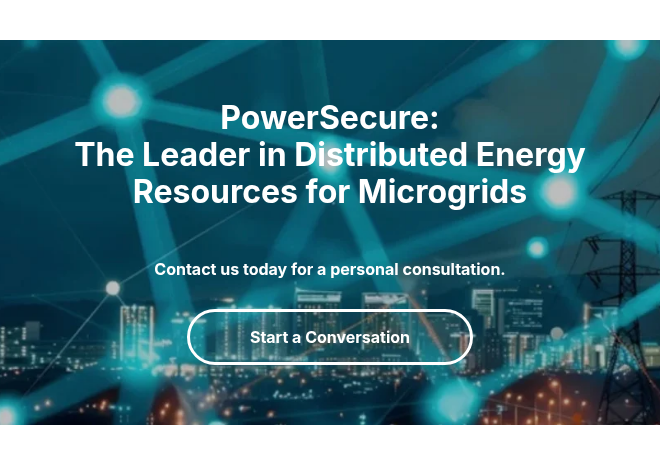Myth 5: Microgrids Cannot Be a Low Carbon Solution
Mar. 28, 2025
Debunking the Myth and Exploring the Reality of Low-Carbon Microgrid Solutions
Businesses increasingly recognize microgrids as a key solution for energy resilience and sustainability. However, a persistent misconception suggests that microgrids cannot be a low carbon solution. This blog, the last of our five-part Distributed Energy Resources (DER) series, highlights how microgrids can play a crucial role in achieving decarbonization goals.
Why the Myth Exists
Like many of our other myths, this one is based on historical precedent. Early microgrids primarily used diesel and natural gas, reinforcing the belief that they contributed significantly to emissions. The rapid evolution of Distributed Energy Resources (DERs) and advanced energy management systems has outpaced public perception. Early scalability concerns led some to doubt whether microgrids could provide sufficient clean power for large-scale applications. However, recent innovations have turned this once-unattainable vision into reality.
Today’s advanced microgrids can incorporate renewable energy sources, energy storage systems, and alternative fuels, enabling them to operate sustainably while ensuring grid stability and resilience. This shift demonstrates that microgrids can indeed support the transition to a net-zero carbon future.
How Microgrids Can Be Low Carbon
Microgrids optimize energy use, minimize waste, and maximize efficiency—leading to significant carbon reductions. Here’s how:
- Hybrid Microgrids – Also known as Advanced Microgrids, these systems incorporate solar, renewable fuels and battery storage to minimize reliance on fossil fuels while maintaining resiliency.
- Adoption of HVO– Hydrotreated Vegetable Oil (HVO) can replace diesel in generators, eliminating reportable fossil-based carbon emissions when 100% HVO is burned.
- Renewable Natural Gas- Natural gas generators can also be used to reduce dependence on fossil fuels through use of renewable natural gas.
- Technology Innovations – AI-driven energy management emissions in a hybrid microgrid.
What Is HVO and How Could It Support Low Carbon Microgrids?
Hydrotreated Vegetable Oil (HVO) offers an alternative to both fossil diesel and biodiesel. Unlike biodiesel, which requires blending and has different chemical properties, HVO is chemically identical to fossil diesel, making it a true drop-in replacement that requires no modifications to existing engines. What makes HVO different? It is produced from renewable and sustainable raw materials. Whether used at 100% purity or blended, HVO provides a practical and immediate solution for businesses and industries looking to decarbonize their operations without sacrificing performance.
Understanding Scope 1, 2, and 3 Emissions in Microgrid Sustainability
To evaluate a microgrid’s carbon neutrality, it’s essential to understand the three scopes of greenhouse gas (GHG) reporting:
- Scope 1 (Direct Emissions) – Emissions from sources owned or controlled by an organization, such as on-site generators.
- Scope 2 (Indirect Emissions from Purchased Energy) – Emissions from electricity purchased and used by an organization. A microgrid that relies on on-site renewable energy eliminates Scope 2 emissions.
- Scope 3 (Indirect Emissions from Supply Chain and Operations) – Emissions from upstream and downstream activities, such as fuel transportation. Microgrids powered by local renewable energy sources, such as HVO, can reduce Scope 3 emissions.
By utilizing renewable fuels like HVO and renewable DERs, microgrids help businesses and communities meet aggressive decarbonization targets across reporting scopes.
 Case Study: 100% Renewable Fuel Microgrid
Case Study: 100% Renewable Fuel Microgrid
The Durham Campus Microgrid Initiative serves as a leading example of a low carbon microgrid. This advanced microgrid features solar energy, battery energy storage, fuel cells and generators operating on HVO. This microgrid provides a real-world demonstration of how advanced microgrid solutions can decarbonize reliable power.
PowerSecure: Your Partner for a Lower Carbon Microgrid Solutions
Microgrids are no longer just a fossil fuel backup power solution. They can be critical to a low-carbon future. PowerSecure’s innovative microgrid solutions help businesses achieve sustainability goals without compromising reliability or efficiency.
Explore more from this series...
Demystifying Microgrids: Truth About Microgrids and Distributed Energy
Myth 4: Any Type of Distributed Energy Resource (DER) Can Be Used to Power a Microgrid Efficiently
DERs: Different Benefits for Different Companies in Different Places Microgrids are known for their…
Myth 3: Can Microgrids Only Address Localized Resiliency Needs?
Aren’t microgrids local energy systems? How can microgrids go beyond localized resiliency? This…
Myth 2: Are Microgrids Too Complex?
To many, microgrids represent an intricate system requiring significant expertise to implement and…
Myth 1: Microgrids Cannot Be Used as a Capacity Resource to Support Utility Capacity Needs
Part 1 of Demystifying Microgrids: The Truth About Microgrids and Distributed Energy Series…

